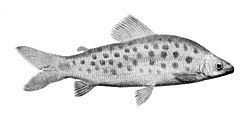| Distichodontidae | |
|---|---|
 | |
| Distichodus maculatus | |
| Scientific classification | |
| Domain: | Eukaryota |
| Kingdom: | Animalia |
| Phylum: | Chordata |
| Class: | Actinopterygii |
| Order: | Characiformes |
| Suborder: | Citharinoidei |
| Family: | Distichodontidae Günther, 1864 |
| Genera | |
see text | |
The Distichodontidae are a family of African freshwater fishes of the order Characiformes. [1]
Two evolutionary grades are found in this family; micropredators (predators of very small organisms like aquatic insect larvae) and herbivores have a nonprotractile upper jaw and a deep to shallow body, while carnivores have a movable upper jaw and an elongated body. [1] Although the herbivores primarily feed on plant material, these species often have omnivorous tendencies. The carnivores include specialized fish-eaters (genus Mesoborus), fin-eaters (Belonophago, Eugnathichthys and Phago) and species that will feed on both whole fish and fins (Ichthyborus). The fin-eaters attack other fish, even ones that are much larger, where they bite off pieces of fins with their sharp teeth. [2] [3] [4]
The fish in Distichodontidae vary greatly in size among species, with the smallest micropredators being less than 8 cm (3.1 in) in length, and the largest herbivores can reach up to 83 cm (33 in). [5]